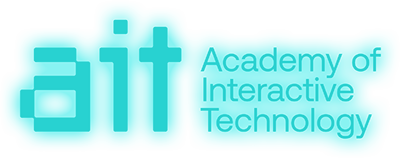How Important are Portfolios in the Creative Industries?
In this blog, we receive expert advice from Tamara Popper, part of AIT’s industry and internship team, as she explains how you can arm yourself with a “stand out” portfolio.
What is a Portfolio?
The word portfolio can be deconstructed into two parts – portare meaning “to carry” in Italian, and foglio meaning “leaf” or “sheet”. Translate that into English (in the context of employment) and it simply means packaging the best of your work (resume, design work), in a portable form.
A portfolio reflects your creative strategies and serves as a display of your abilities and what you can contribute to the job. While a resume gives the hiring managers a summary of where you’ve worked and what you’ve done, the creative industry relies heavily on presentation. In order to stand out, your resume needs to be accompanied by a great portfolio.
“In the highly competitive creative technology job market and limited places at educational institutions, a stand out portfolio is what you need to ensure you‘re on the ‘YES’ pile of the interview list,” says Tamara.
If you don’t see a space to attach a portfolio when applying for a job or course online, make sure that you have a copy (appropriate file size and format) ready to send out just in case the hiring managers make contact.
“Sending over your portfolio can be defined as your first chance at securing that sought-after job or the place in a course you want to study,” Tamara adds.
3 things to consider when creating a portfolio
- Selection
- Presentation
- Formats (Printed and Digital)
Selection:
One of the most important questions is – who are you creating this portfolio for? Are you applying for a job or for admission into a field of study? This identification of audiences should guide the selection of pieces.
“Selecting what works to include in your portfolio, that best represent you and your skill set, is crucial. Step back from each piece and try to be as objective as possible. If you feel any of your choices are not up to scratch or not quite there, leave them out for now – in these cases, less is more,” says Tamara.
A good way to see if your curated pieces resonate well with your target audience is to seek opinions from others – are they able to follow your journey and identify the contribution and highlights of your works?
“Positive criticism is essential, so don’t be afraid to ask your teacher, colleague or a trusted friend to give feedback. You’ll learn from this and your work will improve!”Tamara Popper
Presentation:
Now that you’ve selected your few prize pieces, the art of presenting them comes into place. Ask yourself what is the main purpose of this portfolio? Do you want to capture your learning journey? Or do you want to showcase your final products and best works?
“Employers want to see you shine through your work. Create your own work to include and try to avoid ‘assignment’ style exercises. If you do have work that you’ve collaborated on, clearly state what your role was on the project. Keep the layout and design of your portfolio clean and simple with limited distractions for the viewer, we want them to be captured by your work alone!” says Tamara.
Formats (Printed and Digital)
Having a digital portfolio is as essential as having an offline one (hardcopy version). There are numerous sites, like Behance, which displays your works in a readable and attractive format online. An online portfolio also allows the interviewer to view your accomplishments and gain an understanding of your skills before meeting you face-to-face. Not to forget that a digital portfolio also allows you to create a brand image online.
“Everything is online now, making it a great way to display your work. Sharing it is also as easy as sending a link. Research the platforms for hosting your portfolio or showreel and remember you can have a presence on more than one,” Tamara states.
Don’t neglect the hardcopy portfolio though – they’re handy to bring along with you to interviews and meetings. “For artists, designers and graphic artists, online is important too but it’s still very cool to walk into an interview with a portfolio in hand to present,” Tamara advises.
When you finally combine your resume with your portfolio, both of them could increase your chances of securing that job or clinching that place in the educational institution.
Build your Portfolio with AIT
Here at AIT, we help creative students to build portfolios that they will be proud of. Students in our courses build working apps, produce award-winning short films and animations, create games and build up their portfolios with character sketches and designs.
You can watch our student showreel to get a feel for the sort of work our students create across 2D animation, 3D animation, film, game design and mobile app development. You can also talk to someone at AIT to find out how you could learn the skills you need to launch your own creative career.
Imagine a creative college where you can pursue your dreams in 2D animation, 3D animation, film, game design, IT or mobile app development.
Find out more about AIT and our courses by visiting our connect page and choosing your own adventure. Talk to someone about your study options, book a campus tour and have a look around, chat with a current AIT student or get started on your application.
